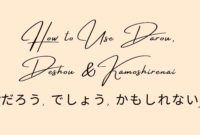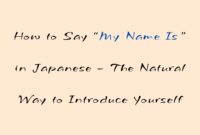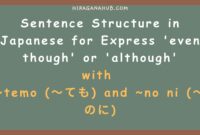Particles To, Ya, and Toka (と、や、とか)
In this lesson, we will learn about three important particles used to list
nouns. These particles work similarly to the word “and” in Indonesian. The
particles used to list nouns or mention equivalent nouns in Japanese are
to (と), ya (や), and
toka (とか). Let’s learn them one by one.

Function of the Particle to (と)
The particle to (と) is used to connect two
nouns, which can be translated as “and” in Indonesian. This
particle is similar to mo (も) that we have
studied before, but to (と) can also mean “with”
or “together.” Here are some examples with
to (と):
-
アメリカのりょうりとイギリスのりょうりとフランスのりょうりがすきです。
Amerika no ryouri to Igirisu no ryouri to Furansu no ryouri
ga suki desu.
I like American food, British food, and French food. -
私は父と兄と一緒に住んでいます。
Watashi wa chichi to ani to issho ni sunde imasu.
I live with my father, older brother, and younger
brother.
Function of the Particle ya (や)
The particle ya (や) also serves to list nouns,
but its meaning is a bit more vague. It can mean “and” like
to (と), but with ya (や), it
implies that there could be other items not mentioned, meaning
“and so on” or “etc.” You can also add
nado (など) to emphasize “and so on.” Here are
some examples:
-
学校でスペイン語の文法や単語やフレーズなどを勉強しています。
Gakkou de Supeingo no bunpou ya tango ya fureezu nado o
benkyou shiteimasu.
At school, I study Spanish grammar, vocabulary, phrases,
and so on. -
私のバッグの中にはノートやペンや消しゴムがあります。
Watashi no baggu no naka ni wa nooto ya pen ya keshigomu ga
arimasu.
In my bag, there are notebooks, pens, erasers, and so
on.
In these examples, there might be other items that are not
mentioned.
Function of the Particle toka (とか)
The particle toka (とか) is very similar to
ya (や) and has the same meaning, “and” or “and
so on.” The difference is that toka (とか) is
more often used in spoken language, while
ya (や) is more commonly found in written
language. Here are examples with toka (とか):
-
イギリスにいたときはサンドイッチとかフィッシュアンドチップスとかを食べました。
Igirisu ni ita toki wa sandoicchi toka fisshu ando chippusu
toka o tabemashita.
When I was in England, I ate sandwiches, fish and chips,
and so on. -
昨日、映画館でコーヒーとかサンドイッチとかを買いました。
Kinou, eigakan de koohii toka sandoicchi toka o
kaimashita.
Yesterday, I bought coffee, sandwiches, and so on at the
movie theater.
The particle toka (とか) is often used in casual
conversations.
Example Sentences:
-
アメリカのりょうりとイギリスのりょうりとフランスのりょうりがすきです。
Amerika no ryouri to Igirisu no ryouri to Furansu no ryouri
ga suki desu.
I like American food, British food, and French food. -
私は父と兄と一緒に住んでいます。
Watashi wa chichi to ani to issho ni sunde imasu.
I live with my father, older brother, and younger
brother. -
イギリスにいたときはサンドイッチとかフィッシュアンドチップスとかを食べました。
Igirisu ni ita toki wa sandoicchi toka fisshu ando chippusu
toka o tabemashita.
When I was in England, I ate sandwiches, fish and chips,
and so on.
Vocabulary:
| Kanji | Hiragana | Romaji | Meaning |
|---|---|---|---|
| 料理 | りょうり | ryouri | food |
| 学校 | がっこう | gakkou | school |
| 文法 | ぶんぽう | bunpou | grammar |
| 単語 | たんご | tango | vocabulary |
| フレーズ | ふれーず | fureezu | phrase |
| バッグ | ばっぐ | baggu | bag |
| ノート | のーと | nooto | notebook |
| ペン | ぺん | pen | pen |
| 消しゴム | けしごむ | keshigomu | eraser |
| サンドイッチ | さんどいっち | sandoicchi | sandwich |
| 映画館 | えいがかん | eigakan | movie theater |
I hope this explanation of と (to),
や (ya), and とか (toka) helps
you understand how to use them in your daily conversations in
Japanese. If something is unclear, feel free to drop a question!
See you in the next post!


